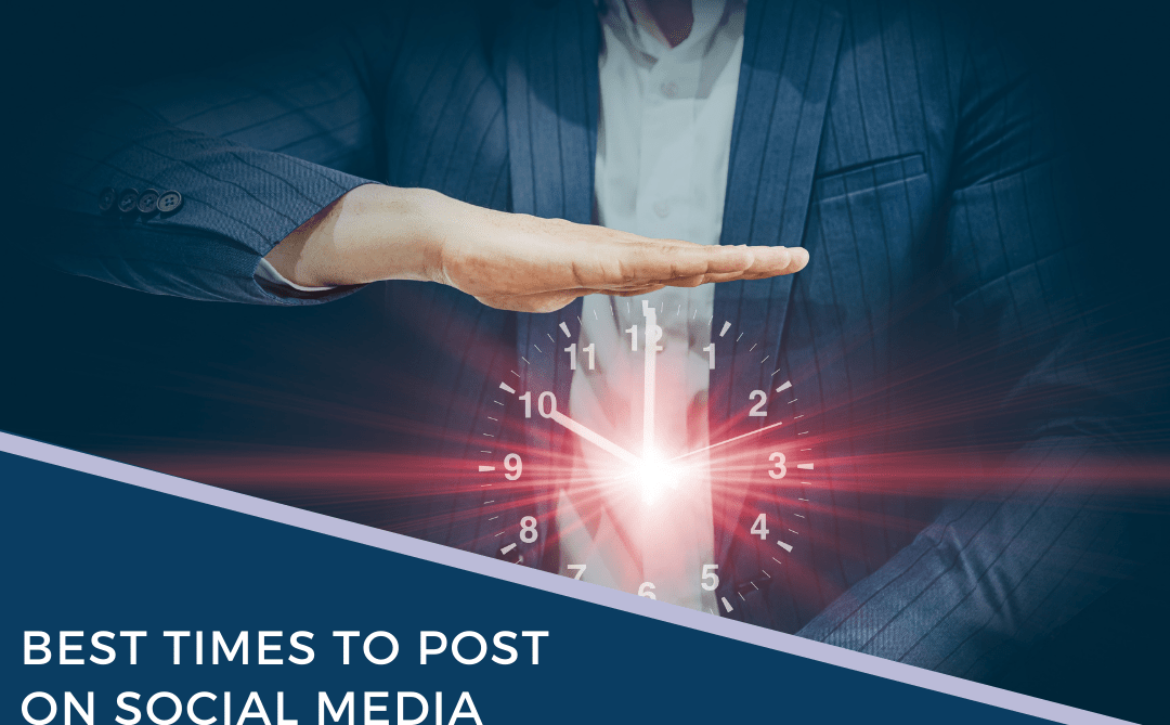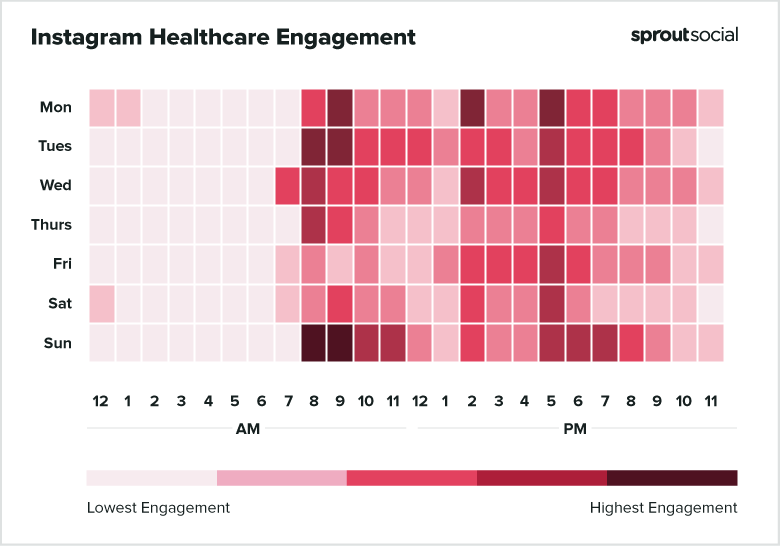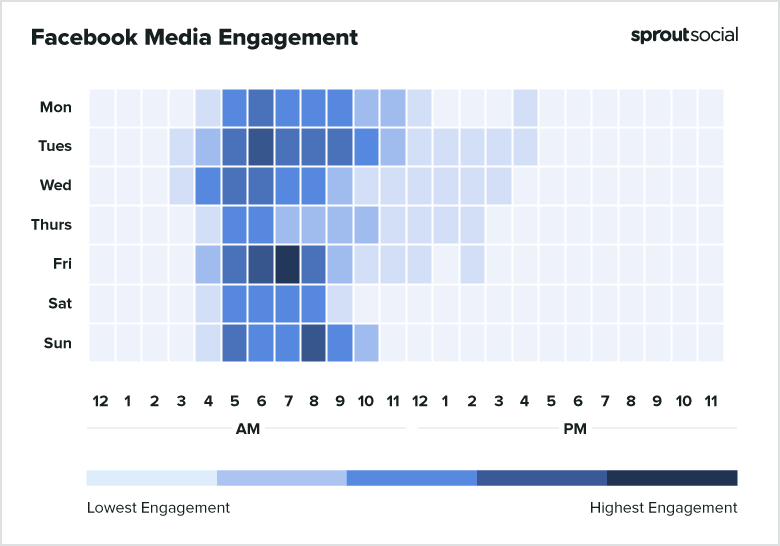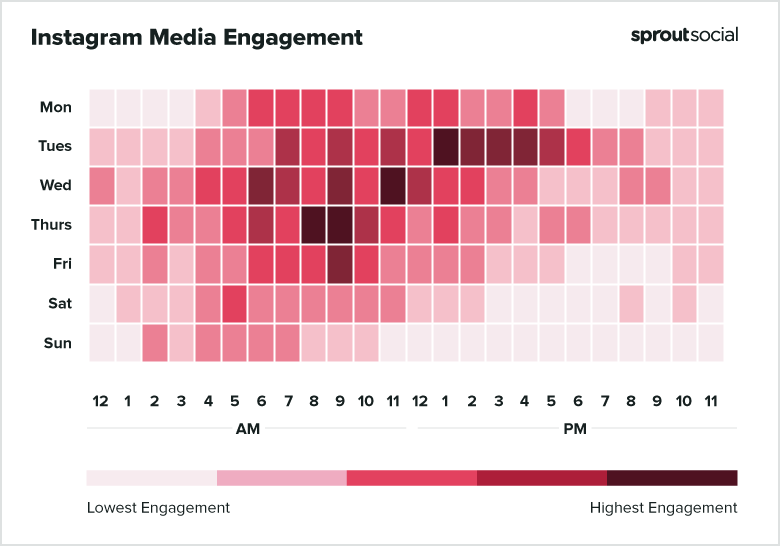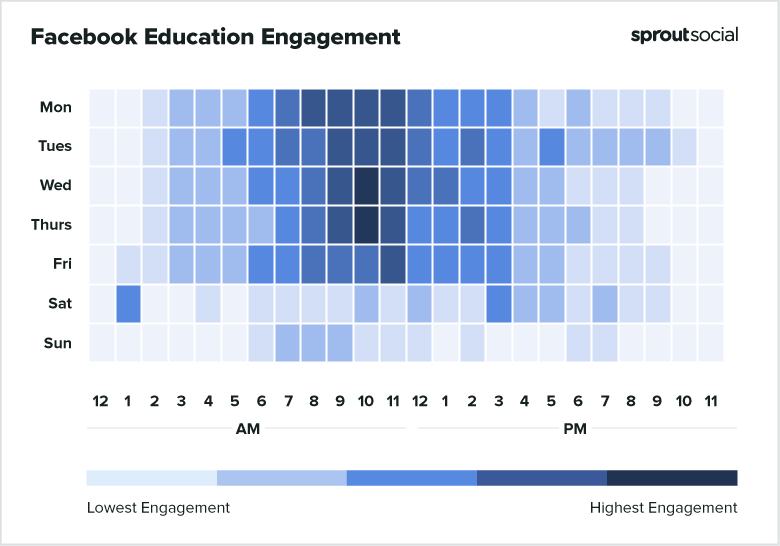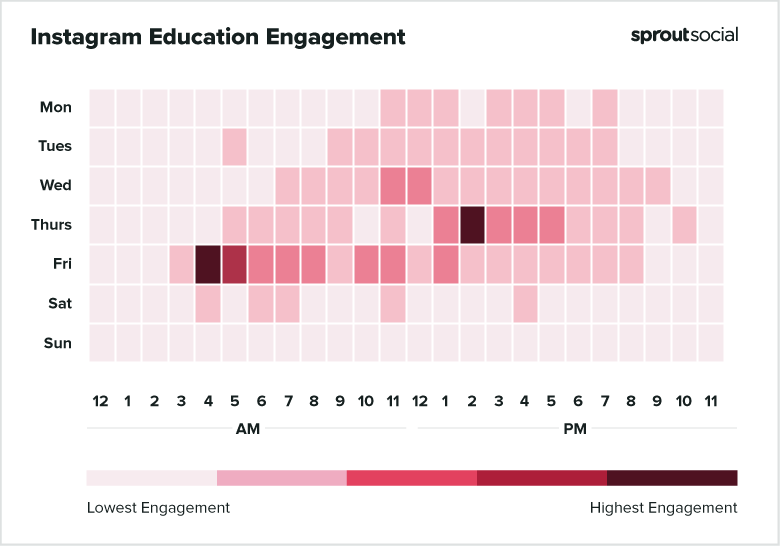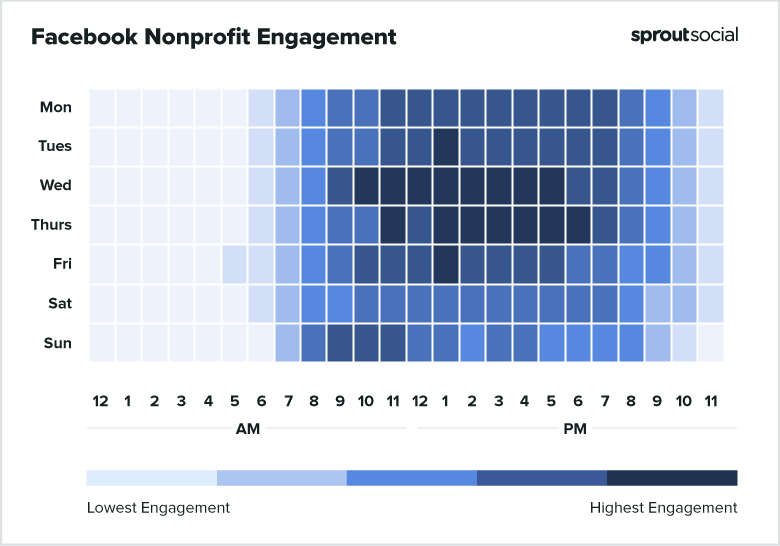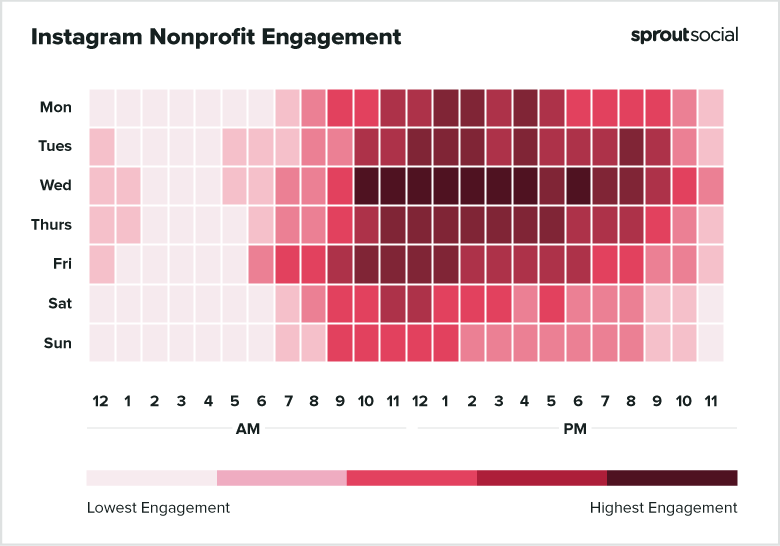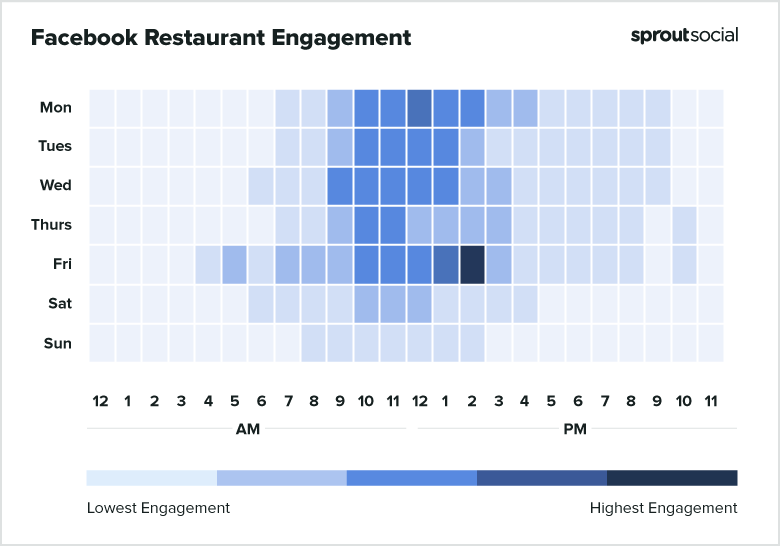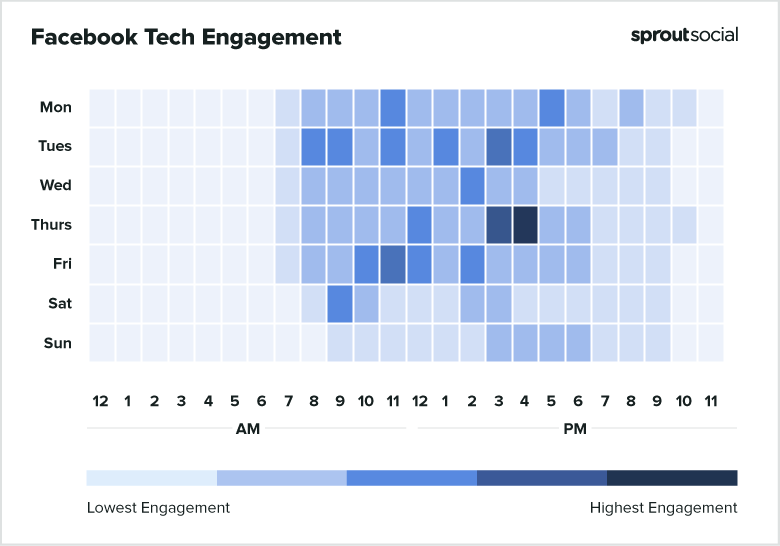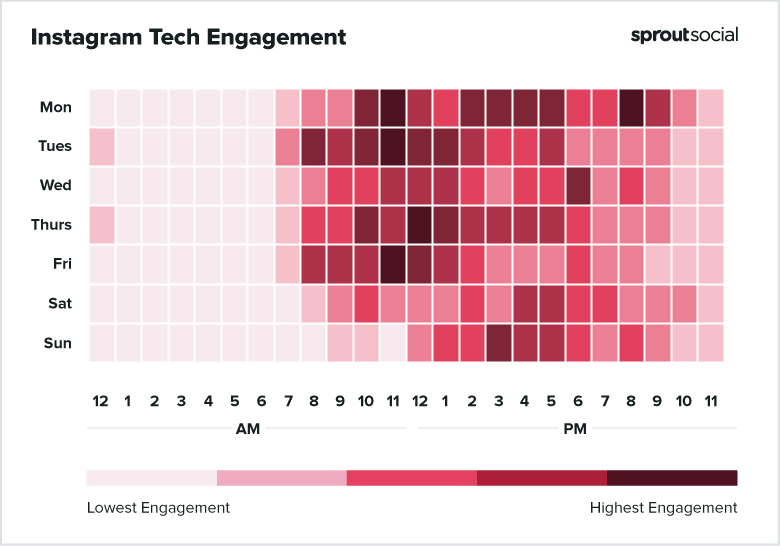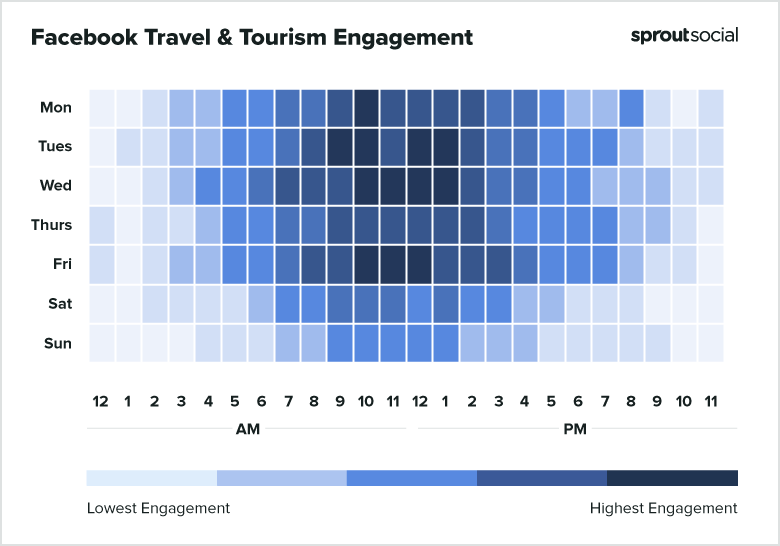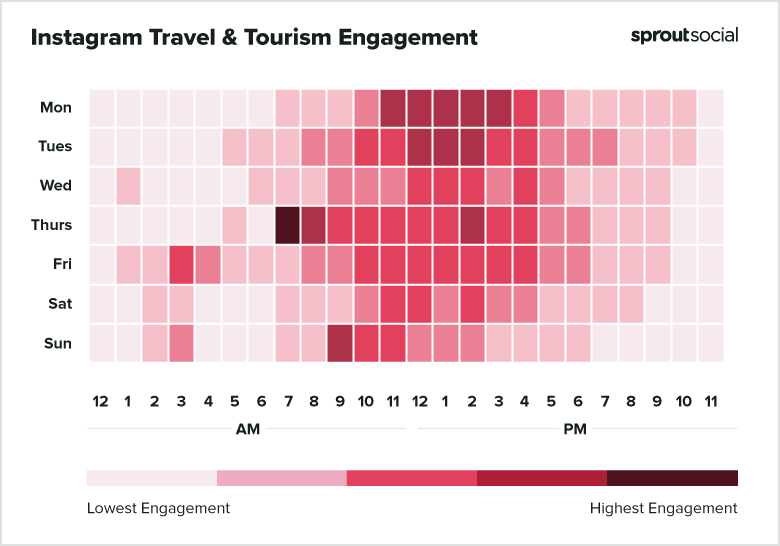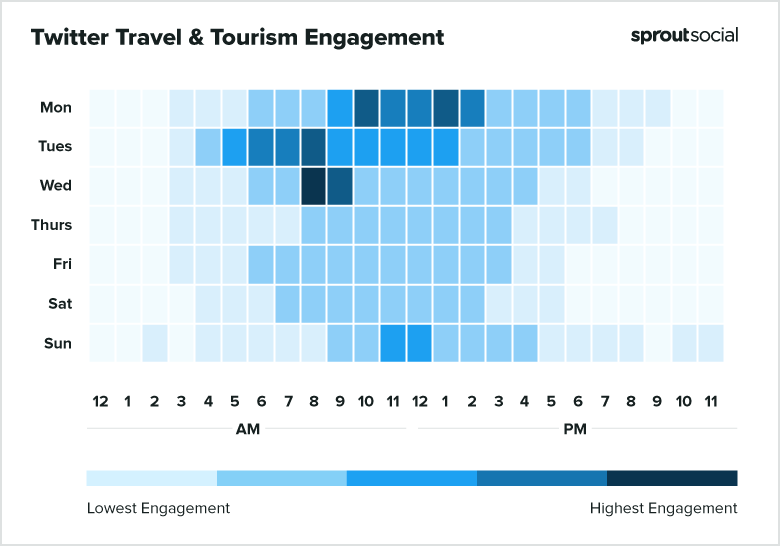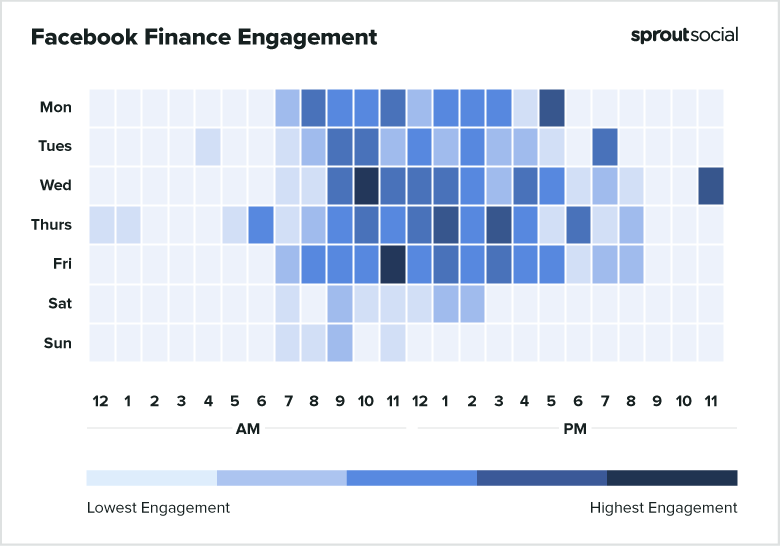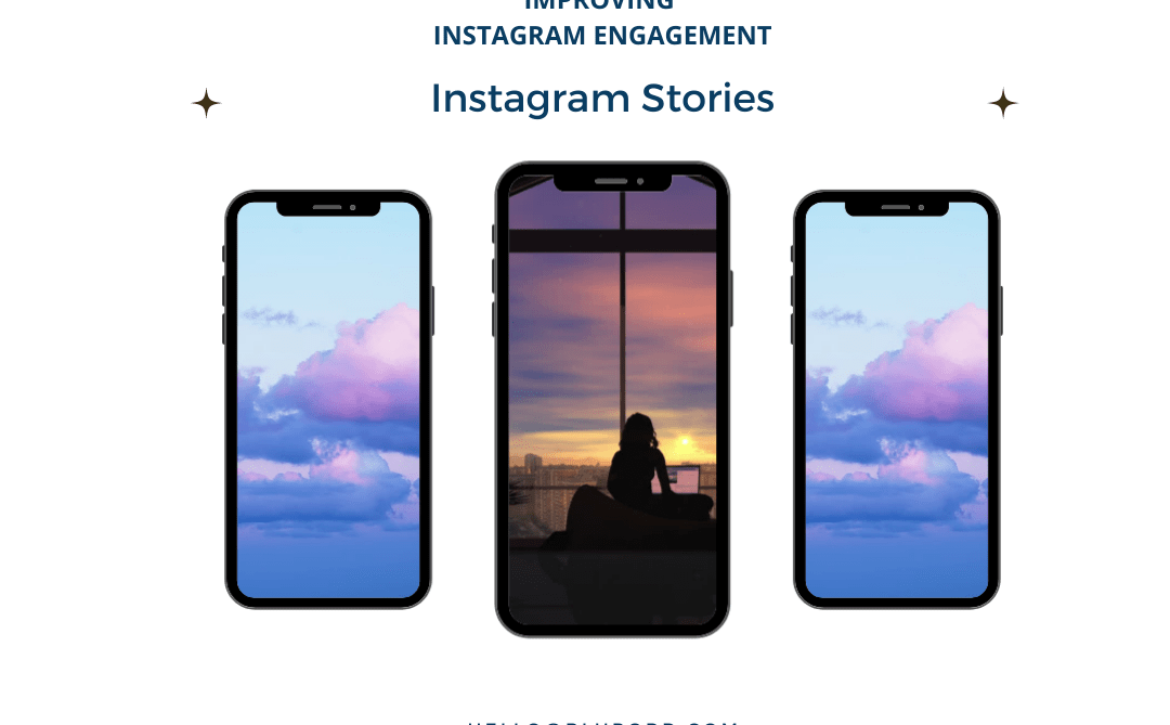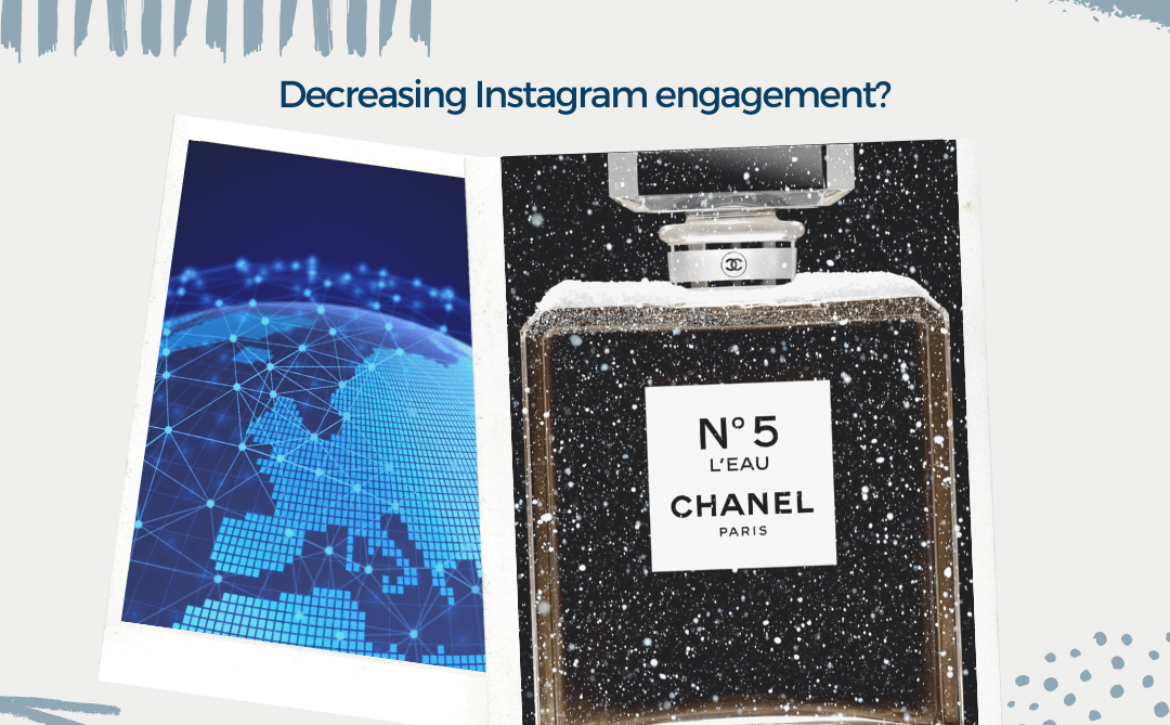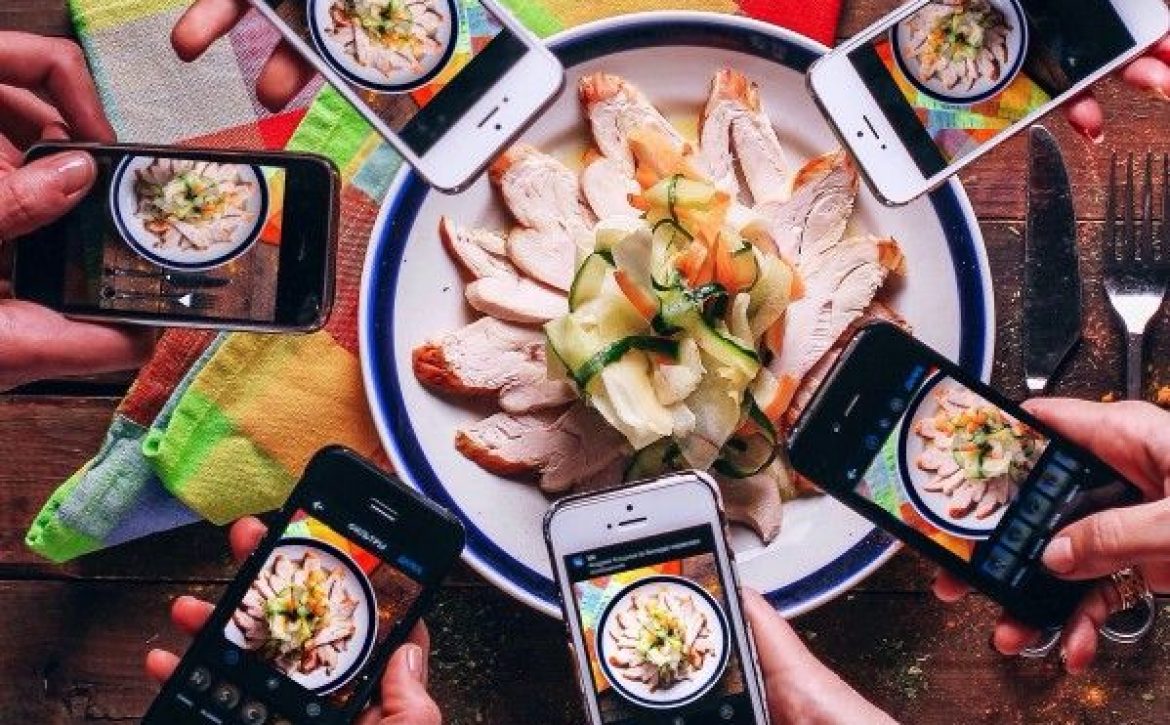Posting on social media – The best times
In the near future, social media will become more important than ever as a way for people to get instant connections, uncover new trends, and get informed on events and such.
To thrive in an unexpectedly rapid digital transformation, businesses had to pivot, and social marketers had to avoid burnout as the volume of social interactions increased with increasing numbers of users.
Considering this, it’s not surprising that our review of the best times to post on Facebook in 2021 uncovered many significant changes, including increased engagement across platforms. Both businesses and their customers were constantly changing how they operate online, resulting in new ways of engagement. As we continue to unravel and refine future strategies, this data assists marketers obtain new perspectives on the ever changing social landscape.
Today you will read more about the best times to post on each platform and suggestions on the times and days to avoid. Besides this information we recommend to conduct your own analysis and draw on the inspiration for scheduling your publishing schedule.
The best times to post on Facebook

Source – sproutsocial
- Best times: Tuesday, Wednesday and Friday 9 a.m.–1 p.m.
- Best days: Tuesday, Wednesday, Friday
- Day to avoid: Saturday
It is not surprising that there was virtually 24/7 engagement on Facebook given that it is the world’s most popular social network.
Reviewing the past year of Facebook data, there were few completely ‘off’ periods. It was more common for businesses to get higher engagement on their content during the weekend, late at night, and early in the morning.
The top times shown above are recorded in US Central Time, so the high engagement in the early morning as well as the more traditional US workday also reflects Facebook’s worldwide reach. It is therefore an ideal platform for brands with an international or multi-location strategy.
The best times to post on Instagram

Source – sproutsocial
- Best times: Tuesday 11 a.m.–2 p.m., Monday through Friday 11 a.m.
- Best day: Tuesday
- Day to avoid: Sunday
In 2020, Instagram continued to roll out new features such as Reels, enhance Stories, and push discovery on the Explore page. The platform was thus ideal for social media audiences struggling with lockdown measures to find and share hobbies – sometimes brands can use social listening to keep up to date as these trends emerge.
On weekdays, engagement became even denser with top times spanning 11 a.m.–2 p.m., and weekends and evenings offered increased engagement options.
Using Instagram to promote your brand content is a great way to reinforce your brand’s visual identity: demonstrate your graphic design skills by showcasing infographics and data reports. The popularity of Instagram Live, like the popularity of Facebook Live, exploded in 2020 as a way to stay connected in an immediate and less curated way. The reels also allow you to make shorter and more viral-ready content that can be used with your feed.
The best times to post on Twitter

Source – sproutsocial
- Best times: Wednesday 9 a.m.– 3 p.m., Tuesday through Thursday 9–11 a.m.
- Best day: Wednesday
- Day to avoid: Saturday
In 2020, many social media users used Twitter to stay updated on developing stories, such as COVID-19 and the US Presidential Election. With this in mind, the platform placed a heavy emphasis on informative and accurate news, with specific trending topics discovery tabs devoted to these stories.
Peak engagement times on Twitter were consistently high through all of the weekdays in 2020, with more high engagement taking place in the evenings. Possibly, this is due to the platform’s continuous focus on news and updates, as well as its role as a hub for entertainment via viral Tweets and memes.
Tweets, while continuing to be an important resource for up-to-date news, also give customers a way to connect directly with brands through conversations and mentions. This means that having a strong customer care strategy in place is particularly valuable because it will enable them to move beyond responding to issues and focus on proactively improving the overall customer experience through social listening and analyzing voice of customer data.
Best times to post on LinkedIn

Source – sproutsocial
- Best times: Tuesday through Thursday 9 a.m.–noon
- Best days: Tuesday and Wednesday
- Day to avoid: Sunday
Engaging with LinkedIn has become extremely consistent during the US work week, which isn’t surprising considering LinkedIn is a professional-focused social network. We found that LinkedIn engagement drops more on the weekend than other social networks we reviewed, making this the worst day to post on the network.
Due to the focus of LinkedIn content on professional thought leadership and career growth, it’s no surprise that the majority of audiences are getting the most value from this content in their working day.
Aside from being an important platform for employee advocacy campaigns and recruiting, LinkedIn has also become a leading platform for creating a variety of content.
LinkedIn is clearly a platform that matches B2B strategies, but any brand can make use of LinkedIn marketing best practices and highlight accomplishments as a business or organization. In addition to employee advocacy, it provides employees with the opportunity to advance their personal brand or professional development by publishing content to their own profiles.
Posting times according to Industry
The research also showed how different industries’ engagement varies across networks and over time throughout the week in addition to reviewing when is a good time to post across all social accounts. This data can be used similarly to our global engagement findings to gain more specific insights into how audiences engage with different types of brands.
Based on our findings, we analyzed data from Facebook, Instagram, and Twitter where there was enough information available to provide an accurate and useful overview of engagement by industry.
Ideal time to post on social media for Healthcare
The healthcare system was faced with an overwhelming challenge in 2020 to adapt to global audiences that were constantly adjusting to new information and living under quarantine restrictions.
Despite some networks, such as Instagram, receiving infrequent engagement in this industry in our 2019 data, in 2020 we saw much more consistent engagement as at-home audiences relied on online sources to stay current and find answers to their questions about the COVID-19 pandemic. For a successful healthcare social media strategy, educating and informing audiences effectively will likely remain a key priority.
Best times to post on Facebook for Healthcare
- Best times: Monday through Friday at 11 a.m.
- Best day: Tuesday
- Worst day: Sunday
Best times to post on Instagram for Healthcare
- Best times: Sunday 8–9 a.m., Tuesday 8 a.m.–noon and 5–8 p.m.
- Best day: Monday, Tuesday
- Worst day: Saturday
Best times to post on Twitter for Healthcare
- Best times: Monday 9 a.m.–noon, Tuesday 8 a.m.-1 p.m.
- Best day: Tuesday
- Worst day: Sunday
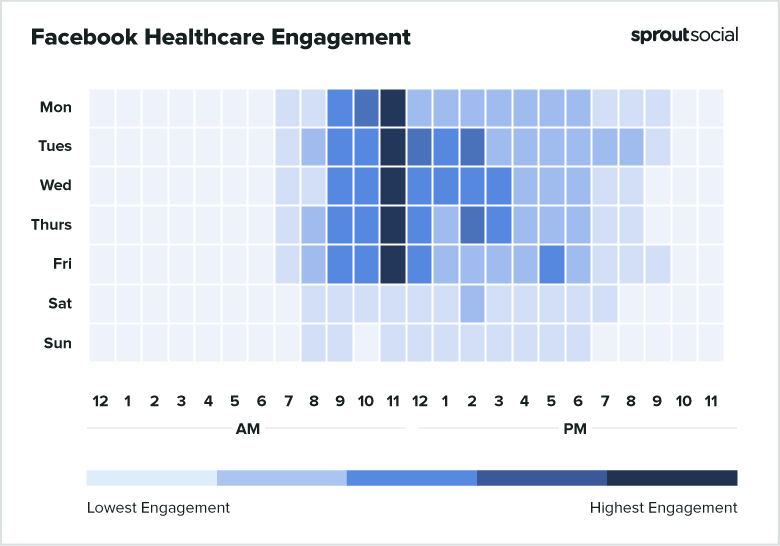
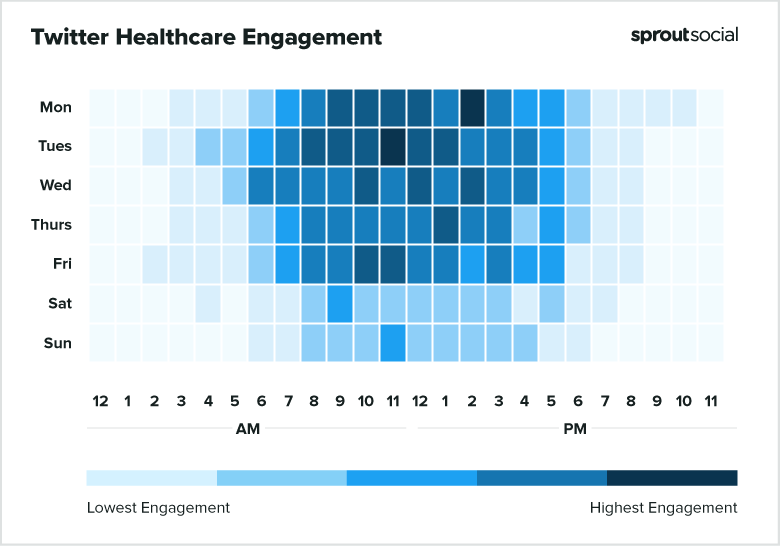
Source – sproutsocial
Ideal time to post on social media for Media
When it comes to engagement in the media industry, Twitter and Instagram were extremely consistent.
Global news and entertainment media have around-the-clock engagement (relative to US central time) due to the relatively large audience globally.
In addition to Facebook’s large global audience, engagement on media industry accounts was especially high in the US morning, perhaps reflecting a tendency for audiences to habitually check in for a longer, single period of time during the day versus quick visits throughout.
Due to the continued scrutiny social platforms undergo as a source of immediate updates and a potential risk for misinformation, it is more important than ever to balance timely reporting with accurate information. Social media journalists and media brands should be aware of their best practices and cultivate overall digital literacy in order to serve their audiences effectively.
Best times to post on Facebook for Media
- Best times: Friday 7 a.m., Tuesday 6–9 a.m.
- Best days: Tuesday, Wednesday, Friday
- Worst day: Saturday
Best times to post on Instagram for Media
- Best times: Tuesday 1–5 p.m. , Wednesday 11 a.m. Thursday 8–9 a.m.
- Best day: Tuesday, Wednesday, Thursday
- Worst day: Sunday
Best times to post on Twitter for Media
- Best times: Monday 6 a.m. & 9 a.m., Tuesday 7 a.m.
- Best day: Monday, Tuesday
- Worst day: Saturday
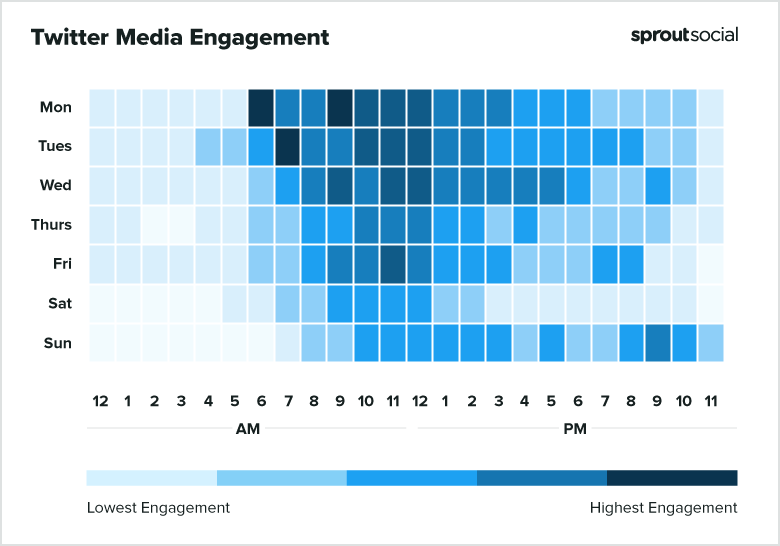
Source – sproutsocial
Ideal time to post on social media for Education
Throughout the day and into the evening, Twitter and Facebook provided significant opportunities for engagement for education. The use of Instagram seemed to be sporadic, but universities and educational institutions shouldn’t overlook the opportunity to showcase their visual identity and show off student life through video content.
Developing a social marketing strategy for education must serve multiple functions, from attracting prospective students to keeping current students and alumni informed. To meet these needs and effectively target these distinct audiences at the right times, many schools will have to manage multiple social media accounts per platform.
Best times to post on Facebook for Education
- Best times: Wednesday and Thursday at 10 a.m.
- Best day: Tuesday, Wednesday
- Worst day: Sunday
Best times to post on Instagram for Education
- Best times: Friday 4–5 a.m., Thursday 2 p.m.
- Best day: Friday
- Worst day: Sunday
Best times to post on Twitter for Education
- Best times: Monday 6– 9 p.m., Thursday 10 a.m.
- Best day: Monday
- Worst day: Sunday
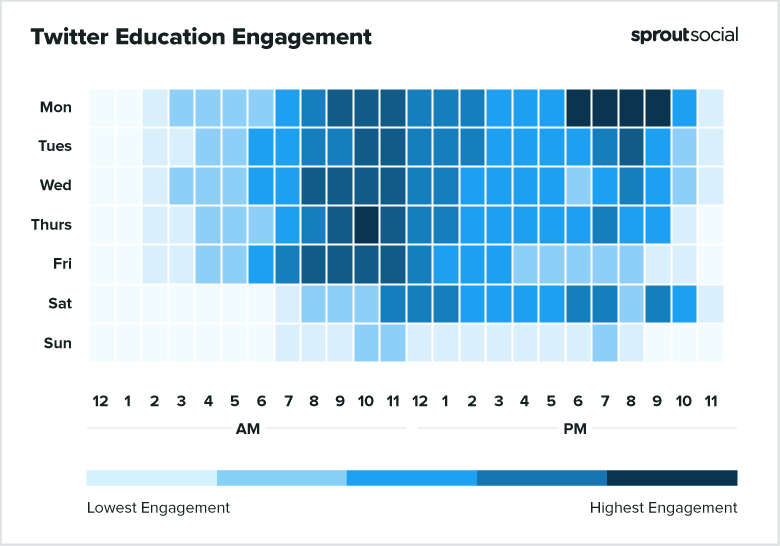
Source – sproutsocial
Ideal time to post on social media for Nonprofits
We examined three social media platforms for nonprofit accounts and found that each of them had strong engagement during the typical US workday. Finding distinct peak times within the relatively solid block of engagement occurring from 8 a.m. to 7 p.m. was almost impossible.
The consistent audience engagement in this space offers a unique opportunity to narrow down your accounts’ individual data even further and find the best time for your specific organization to reach its target audience and achieve its goals.
Plus, since engagement is very similar across all platforms, it makes sense to vary content across them by playing to their unique strengths. Make sure you know what to post on each social network to effectively send your message and encourage your audience to follow you throughout your entire social presence.
Best times to post on Facebook for Nonprofit
- Best times: Wednesday 10 a.m.–5 p.m.
- Best day: Wednesday
- Worst day: Saturday (minor difference)
Best times to post on Instagram for Nonprofit
- Best times: Wednesday 10 a.m.–6 p.m.
- Best day: Wednesday
- Worst day: Sunday
Best times to post on Twitter for Nonprofit
- Best times: Wednesday 10–11 a.m, 2–4 p.m.
- Best day: Wednesday
- Worst day: Sunday
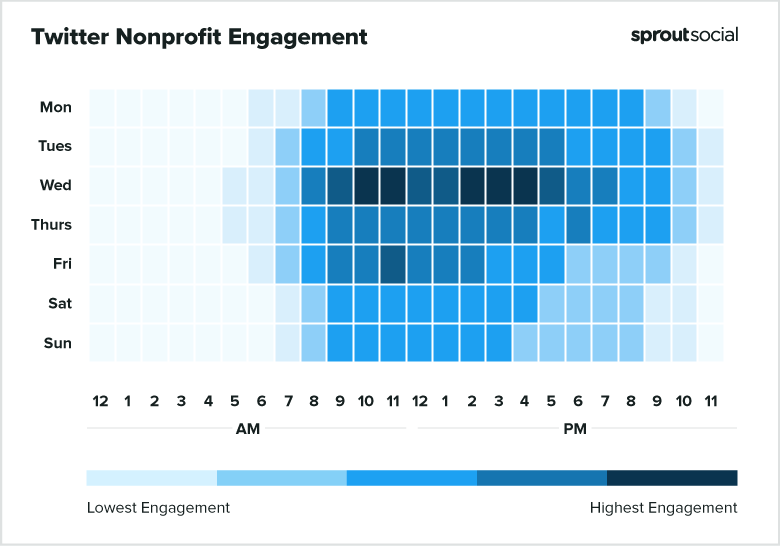
Source – sproutsocial
Ideal time to post on social media for Restaurants
With the demand for takeout and delivery increasing in 2020, restaurants need to inform their customers about changes to service and menus, plus provide social media-ready dine-in experiences.
Instagram is still highly active for the restaurant space despite these changes, with active periods ranging from morning to night.
There are plenty of ways to use Instagram to creatively showcase your menu and delivery offerings, as well as behind-the-scenes shots from your kitchens, even if customers don’t typically take photos of their dining experiences.
Facebook and Twitter engagement varied more erratically over the weekdays, but these platforms still offer opportunities to connect with different audiences. Keep potential customers interested in your restaurant by offering unique promotions and updates tailored to each platform.
Best times to post on Facebook for Restaurants
- Best times: Monday noon, Friday 1–2 p.m.
- Best day: Friday
- Worst day: Sunday
Best times to post on Instagram for Restaurants
- Best times: Monday 9 a.m.–1 p.m.
- Best day: Monday
- Worst day: Saturday
Best times to post on Twitter for Restaurants
- Best times: Wednesday noon–2 p.m., Thursday 8 a.m.–2 p.m.
- Best day: Thursday
- Worst day: Saturday
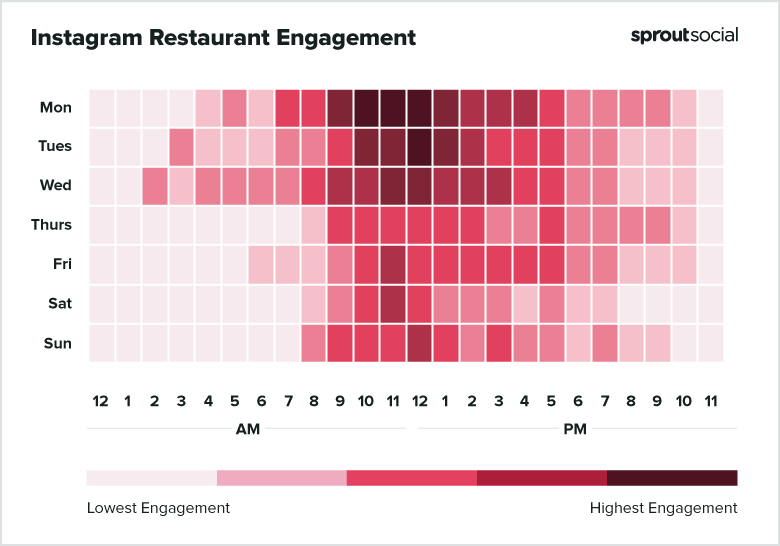
Source – sproutsocial
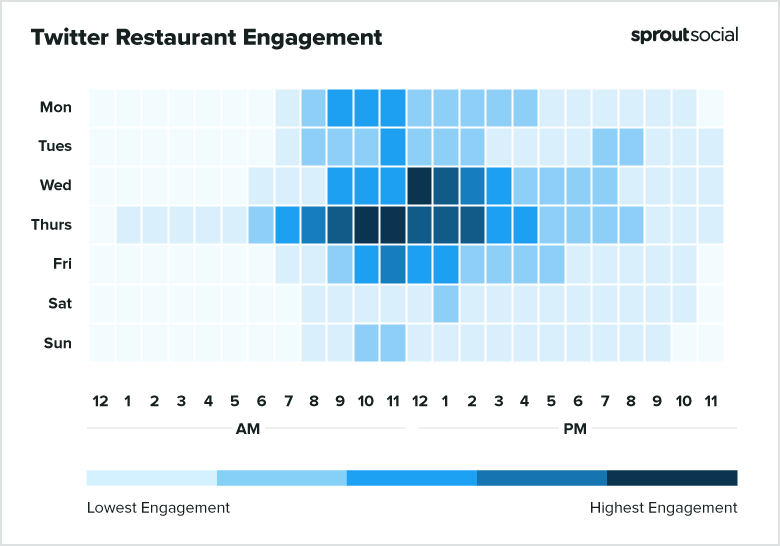
Source – sproutsocial
Ideal time to post on social media for Tech
You might be surprised to learn that Instagram had the highest number of peak posting times for the tech industry. Tech companies such as B2B brands however, can easily showcase both company culture as well as creative visual content such as infographics and reports, which can be employed to highlight both employee advocacy and creative visual content.
B2B buyers also increasingly use social media to do research before making purchasing decisions, similar to B2C customers. Social platforms are also an excellent way for brands to stay in touch with current customers, creating a sense of community around their products and offering meaningful customer support. A strong social media presence can directly impact the bottom line and customer experience for tech brands.
Best times to post on Facebook for Tech
- Best times: Thursday 3–4 p.m.
- Best day: Tuesday, Thursday
- Worst day: Sunday
Best times to post on Instagram for Tech
- Best times: Monday 10–11 a.m., 2–5 p.m., 8 p.m., Tuesday 10 a.m.–1 p.m., Thursday noon, Friday 11 a.m.
- Best day: Monday
- Worst day: Sunday
Best times to post on Twitter for Tech
- Best times: Monday 11 a.m., Tuesday & Wednesday 9 a.m., Tuesday 2 p.m.
- Best day: Tuesday
- Worst day: Sunday
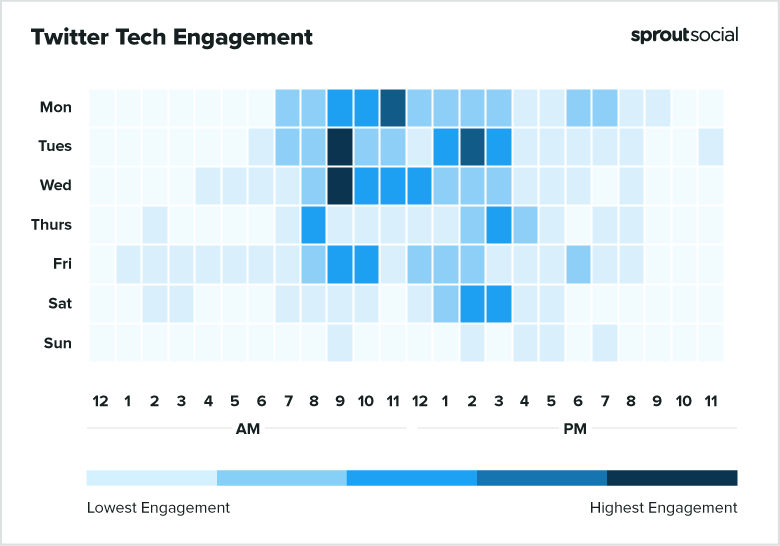
Source – sproutsocial
Ideal time to post on social media for Travel and Tourism
Travel restrictions and travel lockdown limited the traditional ways audiences engaged with the travel, tourism, and hospitality industries on social media throughout 2020, so these industries were forced to innovate and create digital experiences.
We have data showing that social media audiences have responded positively to these efforts, particularly on Facebook and Instagram.
The efforts of tourism brands to share experiences from afar and inspire while using traditional travel photos didn’t fail to hit their target and opened up new opportunities for social marketers in these professions to remain creative and flexible with their strategies.
Best times to post on Facebook for Travel & Tourism
- Best times: Tuesday and Wednesday 9 a.m.–1 p.m., Friday 10 a.m.–noon
- Best day: Wednesday
- Worst day: Sunday
Best times to post on Instagram for Travel & Tourism
- Best times: Thursday 7 a.m., Monday 11 a.m.–3 p.m.
- Best day: Thursday
- Worst days: Saturday, Sunday
Best times to post on Twitter for Travel & Tourism
- Best times: Monday 10 a.m.–2 p.m., Wednesday 8–9 a.m.
- Best day: Monday, Tuesday
- Worst day: Saturday
Ideal time to post on social media for Finance
In order to get an accurate picture of peak engagement times, we focused on Twitter and Facebook, as these platforms are available and provide accurate data about social engagement with financial institutions.
The following does not mean that Instagram should be excluded from social media strategies for banks and financial institutions. The finance industry needs to carefully evaluate the best ways to stay connected with customers on social media while remaining compliant with important regulations.
Twitter had highly varied top times, perhaps reflecting global audiences’ ready engagement with short updates on industry news and markets. Facebook’s weekday activity followed a more typical pattern.
Best times to post on Facebook for Finance
- Best times: Wednesday 9 a.m.–1 p.m., Monday 5 p.m., Friday 11 a.m.
- Best day: Wednesday
- Worst day: Sunday
Best times to post on Twitter for Finance
- Best times: Monday and Tuesday 1–3 a.m., Friday noon–3 p.m.
- Best day: Monday, Tuesday
- Worst day: Saturday
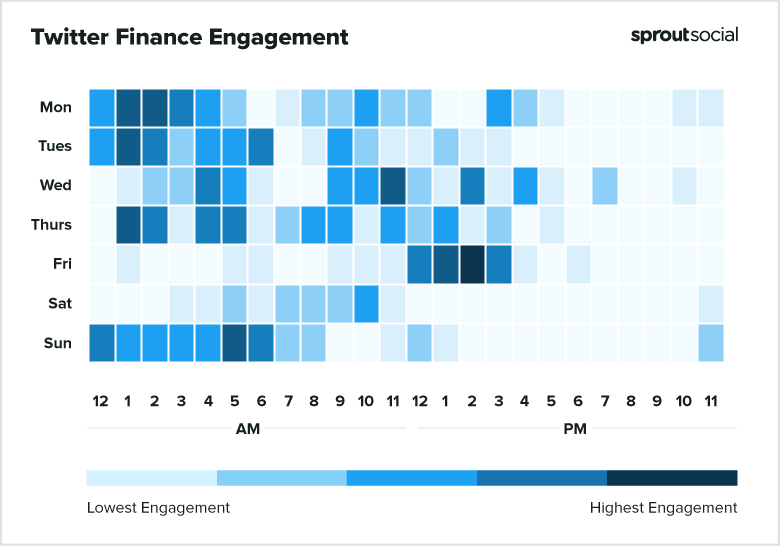
Source – sproutsocial
Ideal time to post on social media for Hospitality
The hospitality industry also faced unexpected challenges to completely revamp their social media content and marketing approach in 2020, similar to the tourism industry. As travel restrictions and limitations changed throughout the year, hospitality brands, many of which manage multiple accounts for multiple locations, had to align on messaging and stay in touch with customers.
The industry’s strong customer service focus was reflected in peak engagement periods, which coincided with US working days and hours, as well as some additional high engagement times in the evening.
The hospitality industry’s overall social strategy must include a holistic approach to reputation management and review management as customers begin planning for travel in 2021 and beyond.
Best times to post on Facebook for Hospitality
- Best times: Monday 11 a.m., Friday 8–11 a.m., Monday, Tuesday and Thursday 4 p.m.
- Best day: Friday
- Worst day: Sunday
Best times to post on Instagram for Hospitality
- Best times: Wednesday noon, Thursday 3–4 p.m., Friday 8 a.m.–noon
- Best day: Friday
- Worst day: Sunday
Best times to post on Twitter for Hospitality
- Best times: Wednesday 3–5 p.m., Thursday 10–11 a.m.
- Best day: Thursday
- Worst day: Sunday
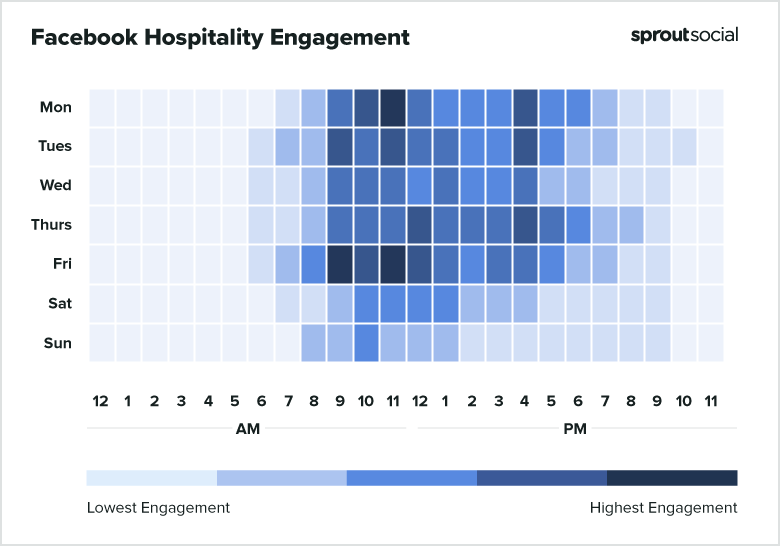
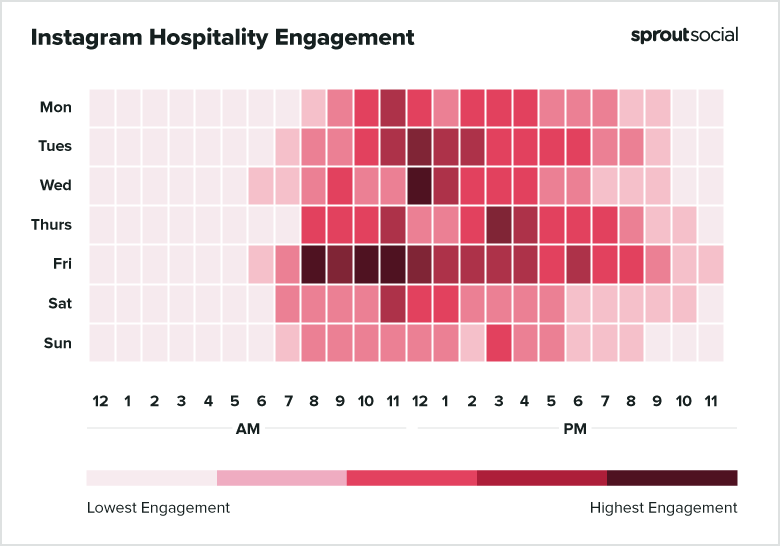
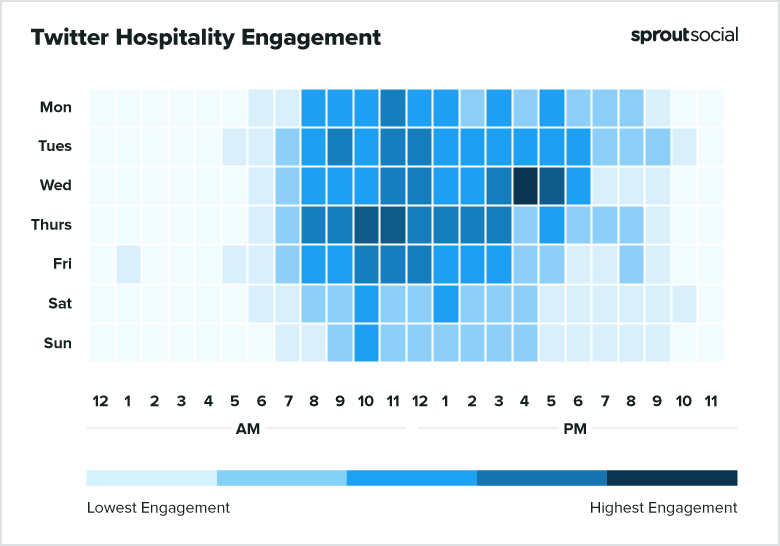
Source – sproutsocial


